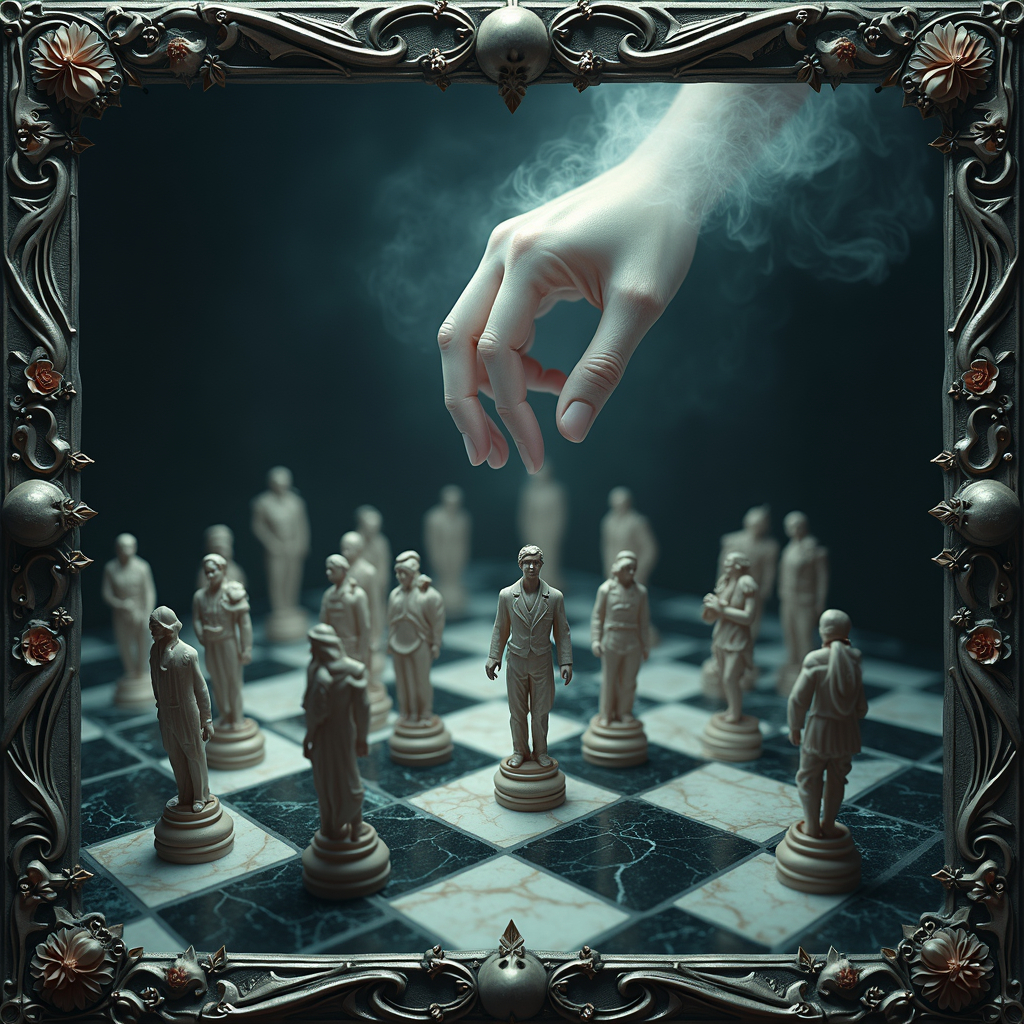
They walk among ruins and riches, memories and myths — gods who were once human. The Prir, known as the
Walking Gods,
are not born divine but become divine. Some ascended through great deeds or deep wisdom. Others stumbled into
godhood by sheer chance, cruel fate, or cosmic whim. A few were elevated as reward, others as punishment. The
universe, it seems, has a sense of humor.
No two Prir are alike. Some are benevolent protectors, lighting the way for their followers. Others are
unpredictable, vengeful, or wholly indifferent to mortal concerns. Some still whisper to their worshipers,
guide
kings, or stir the wind over battlefields. Others have vanished into silence, lost in their own eternity.
Yet all share one truth: their power is not infinite. It ebbs and flows with the devotion of those who
believe.
Worship is the lifeblood of a Prir. Shrines, prayers, songs, and sacrifices feed their essence. A forgotten
god is a
fading god. A beloved one burns like a star.
To understand the Prir is to understand the heights and failings of mortal existence itself — magnified,
eternal, and walking
still.
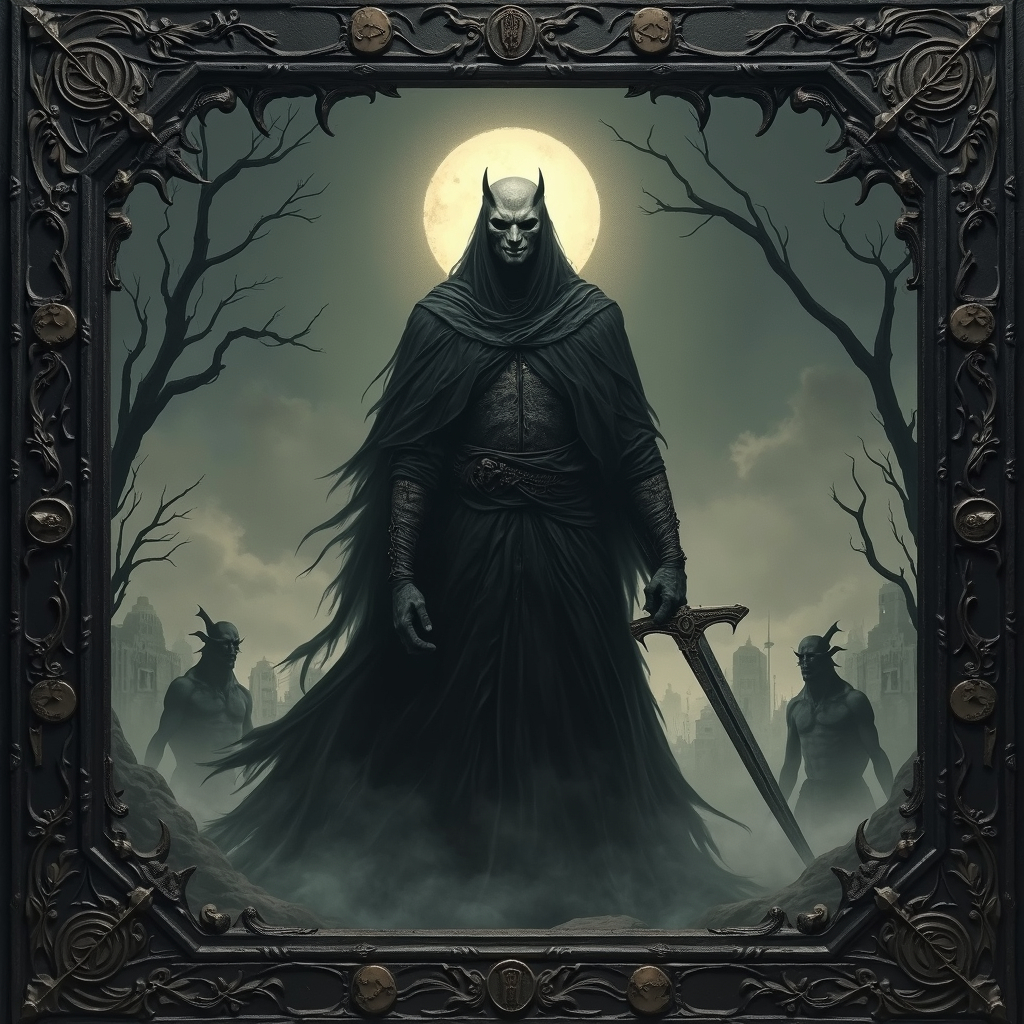
Chernabog
God of misfortune and corruption. Patron to the downtrodden
"I am not your punishment. I am what comes when you pretend the world is just."
Among all the Prir and twisted divines that haunt Skazka’s mythic past, Chernabog is the shadow cast by hope
itself. Once a forsaken mortal, cursed by fate or Kaos itself, he became god not by ascension, but through
corruption, hatred, and the mockery of divine pity. Chernabog is misfortune made incarnate: cold, inevitable,
and
patient.
Symbols
- The Blighted Eye: A cracked, blackened eye weeping ash—seen etched on cursed altars, hidden in
desperate
places.
- Withered Tree: Once lush, now hollow and lifeless. Often carved where misfortune lingers long.
- The Eclipse Halo: A black circle around a pale disc—an eternal reminder of his birth beneath a dying
sun.
Domains
- Misfortune: Wherever luck turns bitter and triumphs collapse, Chernabog walks unseen.
- Despair: Not raw destruction, but carefully sown ruin—turning hope to ash and bonds to blades.
- Corruption: He is not the chaos of Kaos, but its precision; a seed of rot planted in systems and
souls.
- Creation of Monsters: From his rage, he forged the orcs—brutal reflections of his own exile.
Rites
- The Mask of Ruin: Said to be worn by Chernabog when walking among mortals. It bears no eyes, only a
faint
smile. It is now a symbol worn by priests of this deity.
- Ashblade: A sword carried by his earliest orc warlords, forged from volcanic glass and regret. It
breaks
not bodies, but loyalty. Said to be used to ordain priests in to the ranks of Chernabog.
- The Thousand Whispers: A forbidden prayer spoken only by those who have lost everything. The prayer
does
not ask for aid — it asks for vengeance through entropy.
Lore
- The Founding of the First Orc: Beneath the Dead Peak, Chernabog shaped the first orc from stone, ash,
and raw will. He did not gift them purpose — he gave them anger. Their hearts burn with echoes of Chernabog’s
first scream.
- The Ashfall War: When the orcs flooded from his sanctum, no god knew where the tide would end. Cities
vanished beneath choking smoke. Chernabog himself never lifted a blade — he whispered, and kings tore down
their own
thrones.
- The Banishment: The Annarr, unified in fear, shattered Chernabog’s name, divided his orc legions, and
sealed his sanctum. For a thousand years his name was erased from stone, song, and prayer. But misfortune does
not
sleep.
- Worship & Fear: Chernabog is not worshipped openly. His name is muttered only by the
broken—prisoners,
the plague-touched, exiled warlords. Secret cults called The Hollowed Eye plant despair deliberately,
believing
that only ruin brings truth.
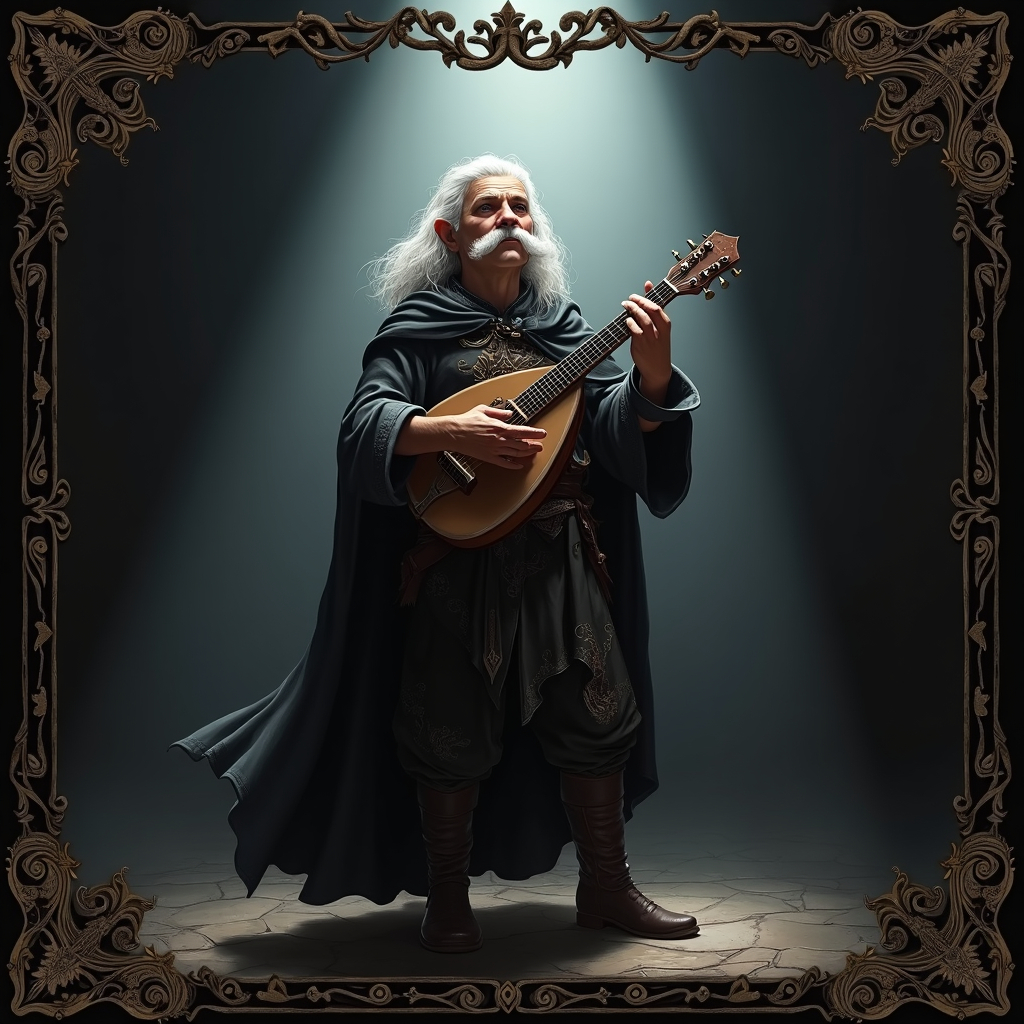
Herukan
God of song, memory and revelation. Patron to bards.
Born in the shadowed alleys of Varn Hollow under a blood moon, Herukan, a gnome with hauntingly large eyes and
nimble fingers, was sold to the Carnival of the Shrieking Bell by his parents who could not afford to raise him.
Amid cruelty and fractured instruments, he learned to
channel sorrow through his harp-like voice. One night, after a brutal beating, his lament awake a Shard of
Uzume, an
ancient fragment of song-power buried in nearby for thousands of years. The shard fused with his soul, and in
his next performance, time itself stopped. Herukan, through no choice of his own,
ascended and became god of song and emotional transformation — one who sings and the world obeys.
Symbols
- The Shattered Bell: A cracked handbell, often worn as a pendant. It represents the broken silence
Herukan shattered with
his song at the carnival of the Shrieking Bell. Worshippers never ring it—only wear it. To ring it is to beg
for a voice
in the silence of despair.
- “When silence hurts, I listen.”: Whispered creed of Herukan’s faithful.
- The Spiral Harp :An impossible harp whose strings spiral into infinity. Appears in murals and
frescoes. Used as an emblem by bardic orders aligned with Herukan’s truth-driven music.
- The Mask with No Mouth: A simple theatre mask with no mouth, only expressive eye slits. A symbol of
those who were never
heard. Carried by orphans, the exiled, and abused performers. When a follower sings
with it placed beside them, it’s said Herukan sings in harmony.
Domains
- Song & Emotion: His voice commands tears and ecstasy, weaving potent emotional resonance into all who
hear him.
- Memory & Loss: He gives form to grief, unlocks nostalgia, and binds memory with melody.
- Revelation & Truth: In his harmonies, hidden truths surface; lies unravel to silence.
- Veil & Inter-Realm Chorus: Herukan bridges realms, warping reality through sound.
Rites
-
The Blood-Moon Lament: During lunar eclipses, gnome bards perform low dirges in acoustic chambers. As
tears flow, they believe Herukan listens — rekindling empathy in a world grown harsh.
-
Carnival’s Silence: Displaced performers hang broken instruments at doorways. Once silent, they are
never played again — tokens of respect for
the night Herukan’s song turned sorrow into cosmic pause.
-
Shard-Adaptive Hymn: melodies are sung in layered counterpoint until the air quivers. When done
correctly, singers claim to feel doorways open beyond mortal perception.
Lore
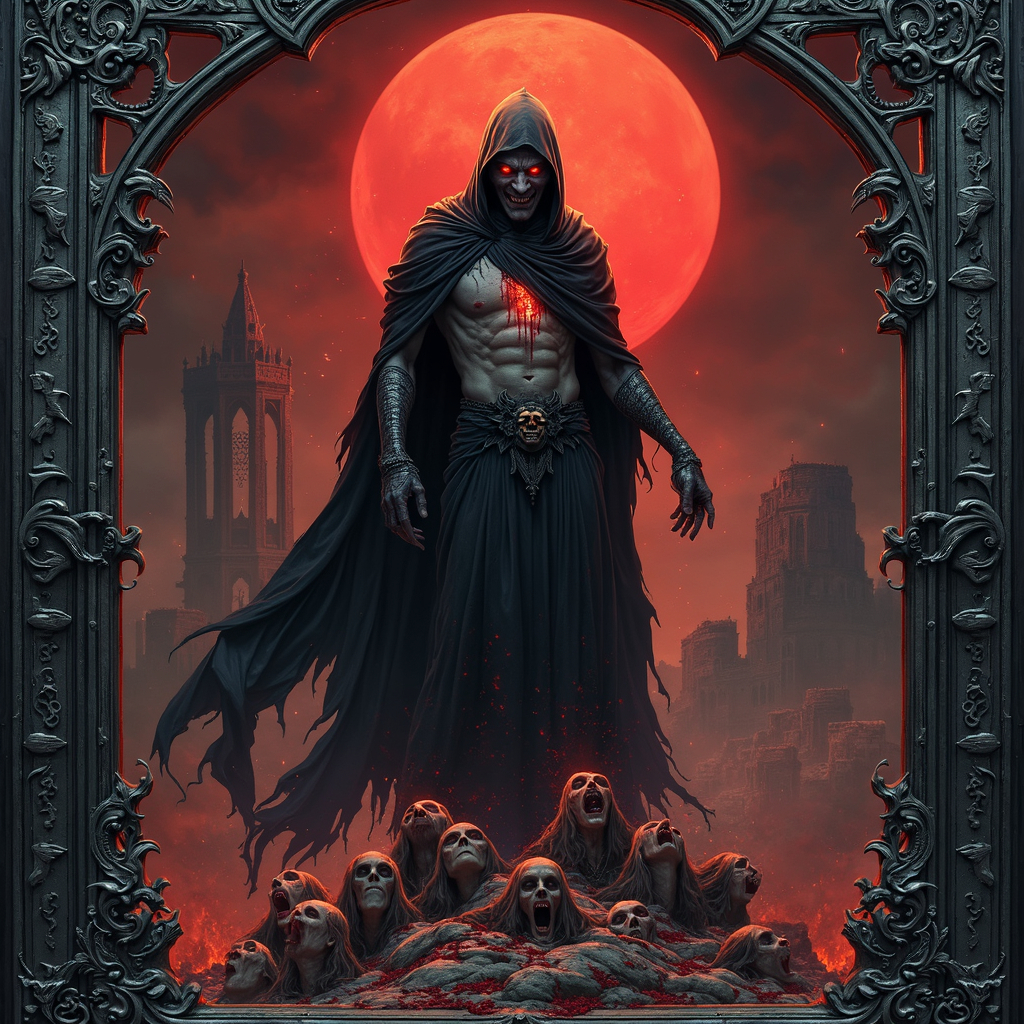
Mortifer
Lord of murder and ambition. Patron to assassins and serial killers.
“A blade, a name, a silence. This is his prayer.” — from the banned Velkarian Catechism of Knives
Mortifer was born beneath the counting-houses of Velkaria, ignored even by his own lineage. He watched as
brothers
inherited, sisters were adored, and his father spoke only of legacy — never his. His first kill was not rage,
but
experiment. The next, calculation. Then came artistry. As the bodies fell and his family's line crumbled,
Mortifer’s
name rose like smoke over a ruined ledger. But even wealth and titles could not still his hunger. He turned to
the
forbidden: blood sorcery, exile-born rites, the carving of power into flesh.
On a night soaked in red moonlight, Mortifer killed the city’s entire merchant council — thirteen blades,
thirteen
names, thirteen deaths in one breath. When dawn broke, he stood alone amidst chaos, not merely feared but
revered. The
divine took notice — not to bless him, but to acknowledge him. With each murder done in ambition, his essence
deepened.
With each assassin’s whisper, his shadow lengthened.
He is now worshipped in silence, invoked without voice. No church dares claim him — and yet every assassin,
every
traitor, every power-hungry soul knows his mark. He is the god of murder not as madness, but as method.
Symbols
- A nod and a wink: A blood-slick dagger plunged into a coin; this is the calling card of those who
serve Mortifer.
- A dire warning: a severed hand clutching thirteen black threads; this is the symbol which indicates
refuge is close-by for those who follow the Lord of Murder.
- Guess whose coming to dinner: a tarot card with a red crescent moon biting through darkness; a gift
given to those a devotee intends on killing.
Domains
- Planned to perfection: Mortifier is not just about murder, but murder which is planned immactulately.
- Slay thy borother: ambition above everything else. Even family should not be above scheming.
Rites
- The Rite of Thirteen: A ritual killing involving thirteen symbolic elements — thirteen blades,
thirteen heartbeats, thirteen names whispered. Said to draw Mortifer's gaze directly and confer dark favor or
protection in exchange for the killer’s own soul fraying.
- Velkarian Marking: Practitioners slice the rune of Mortifer — an angular glyph resembling a dagger
through an eye — into their skin before committing a murder-for-power. Done properly, the mark never scars,
only deepens.
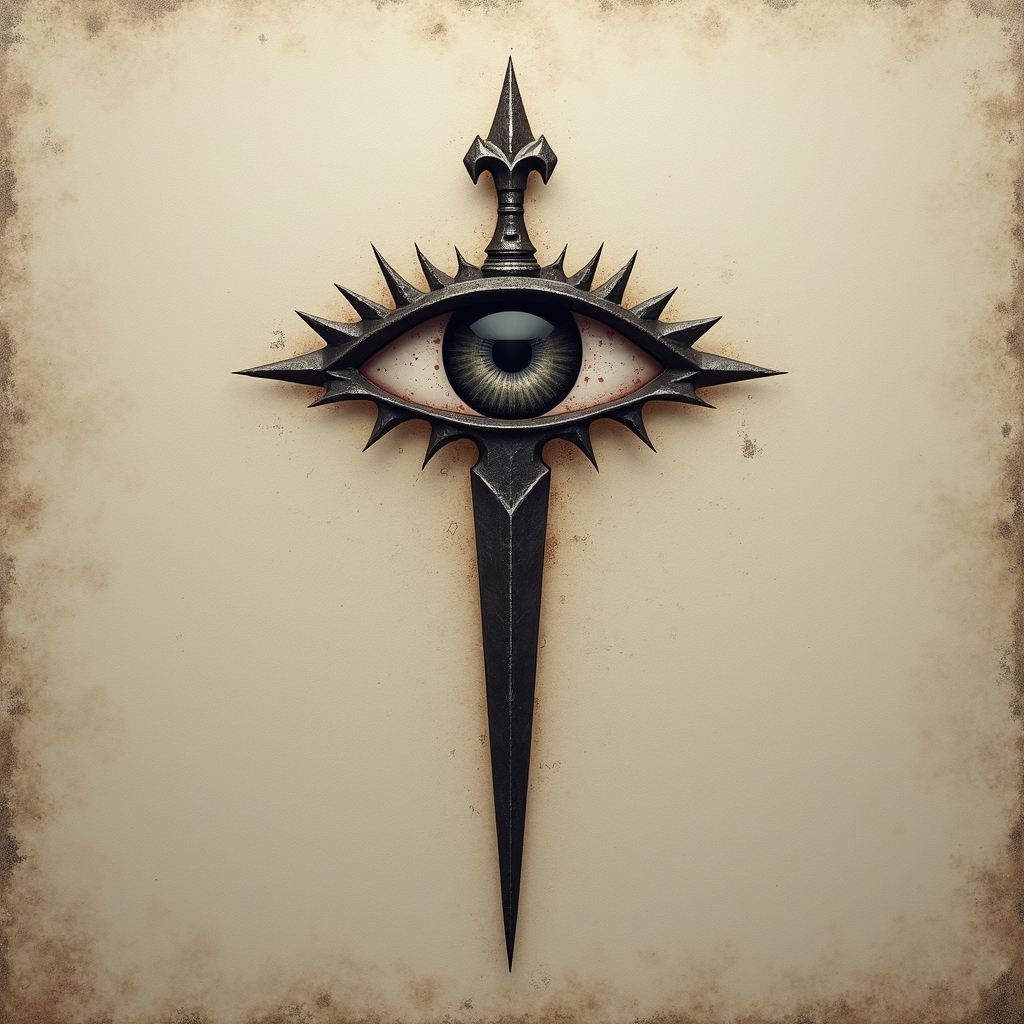
- The Crimson Silence: A vow taken by assassins, never to speak of the act once done. Each broken vow
supposedly awakens a fragment of Mortifer within, leading to madness or worse — divine possession.
Lore
- Mortifer was not born divine: he proved himself divine. In the mercantile sprawl of Velkaria, where
merchants bartered souls and family was priced in ledgers, he was a forgotten child: the seventh son, the
unmentioned heir. But Mortifer did not beg for legacy. He seized it, body by body, crime by crime, blade by
blade. His murders were not acts of madness — they were assertions of order, deliberate, ritualistic,
inevitable.
- He rose by subtraction: thinning the world of his rivals until only he remained. The gods took notice
when mortals fled from his shadow rather than from theirs. They watched as he carved divinity into himself —
not through worship, but through work.
- He has no temples, only scenes of crime
: His sermons are written in bloodstains. His hymns are
final breaths.
- The Ledger of Unspoken Names: A tattered book said to list every name Mortifer has claimed. No ink,
only impressions — names felt rather than read.
- The Dagger of Final Inheritance: A black-bladed relic believed to be the very knife used to slay the
merchant council. It thirsts audibly when near betrayal.
- The Silence-Bound Psalms: Etched onto bone, readable only under blood-moonlight. Reciting one is said
to hide a murderer from all gods — save Mortifer.
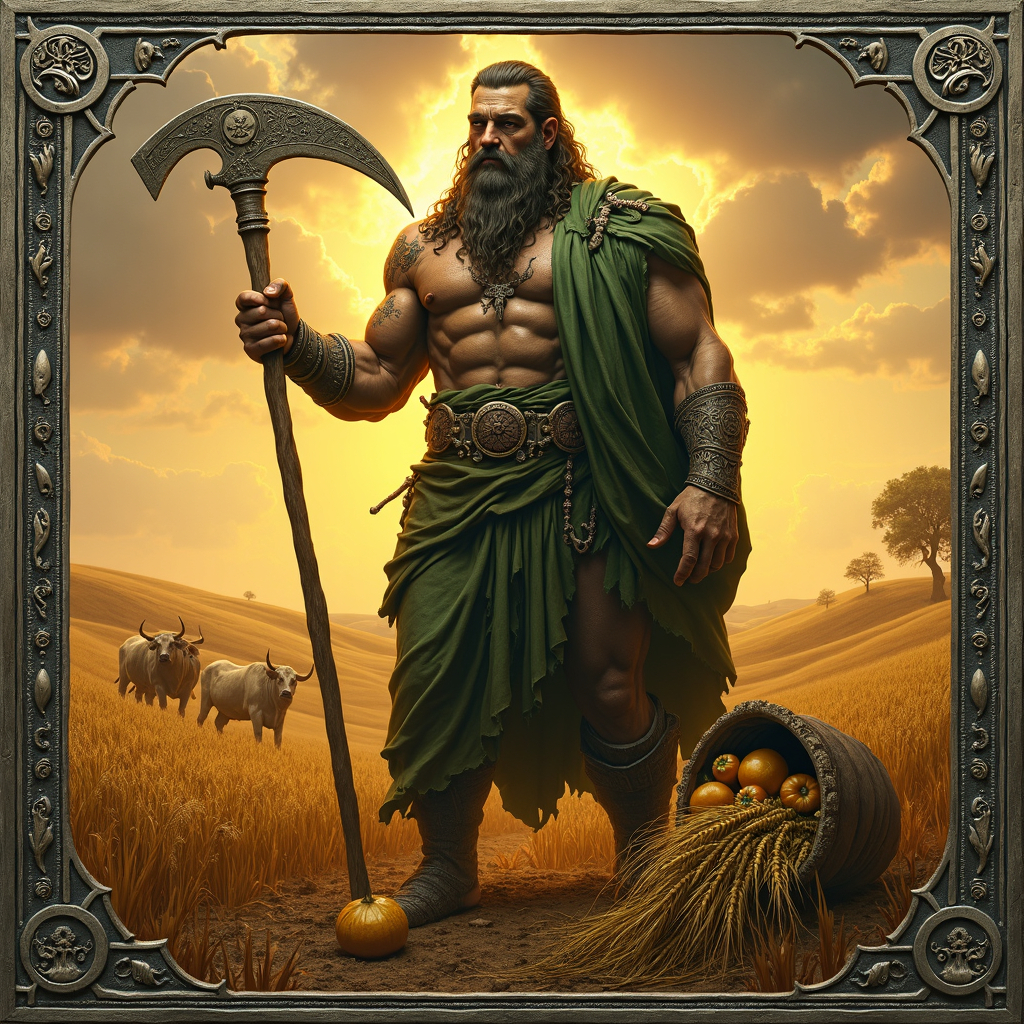
Agos
God of farming, agriculture and the seasons. Patron to farmers and anyone who works on the land.
Agos, the hulking god of farming and agriculture, stands as a sentinel over the soil and its stewards. Often
portrayed as a muscular, earth-streaked farmer wielding a broad scythe, he embodies the sweat and strength
required to coax bounty from the land. He was especially revered by the Sken, the hardy folk who migrated from Skia to Kelos
centuries ago, bringing with them veneration for Agos and integrating his worship deeply into their agrarian
culture.
Symbols
- Scythe: A broad, curved blade used for harvesting, symbolizing both the cutting of ripe crops and the
severing of blight.
- Cornucopia of Grain & Gourd: Often seen at his feet, representing the harvest’s abundance and the
nourishing cycles of growth.
- Oxen yoke: Symbolic of strength, partnership between man and beast, and the burdens borne for a
fruitful yield.
- Green-and-Brown Robes:: His garments are dyed in the soil and sprout-green hues, a living tapestry of
earth and growth.
Domains
- Agriculture & Harvest:: Patron of sowing, tending, and reaping—seasonal cycles are his domain.
- Soil and growth: Oversees fertility, irrigation, and the unseen work in the earth.
- Labour and strength: He honors toil, diligence, perseverance; the very bones of a farmer echo his
divine essence.
- Cycles of decay and renewal: Agos embraces that every harvest is tied to death and rebirth—stubble
fields feed renewal.
Rites
- Breaking the first furrow: At spring’s first plowing, farmers dedicate the fresh earth, sprinkling
seed and wine at Agos’s shrine, invoking his blessing.
- Mid-Summer Scythe Blessing: Villagers ceremonially sharpen scythes and pass them near a hearth fire,
offering tobacco or sweet grain to ensure a swift harvest.
- Harvest Feast (“Agos’ Abundance”): A communal celebration at harvest’s end with bread shaped like
earthen mounds, singing of toil and thanks, and the first sheaf carried in procession to the temple.
- Stubble blessing: After harvest, participants leap over burned stubble while singing an old chant to
cleanse any lingering pestilence.
Lore
- The Sken Pilgrimage: Legend tells of a migration from Skia to Kelos, where floods and famine once
struck the early Sken settlements. A humble farmer named Khelan prayed to Agos, and by sunrise, the clouds parted,
revealing fertile land. The Sken built an altar on a grassy ridge where Khelan first sowed seed in Kelos, and
for generations, every new settlement began with that same rite.
- The Tale of the Iron Field: A rich landowner, hoping to expand his domain, cursed a field, believing
he could control Agos’s bounty with iron spikes. Crops failed, cattle sickened, and his family fell into
despair — until a peasant girl, Marisa, removed the spikes and reburied them deep in the earth. With that act of
humility, Agos restored the field, teaching that reverence outweighs dominion over the land’s spirit.
- The Trials of the Green Scythe: Agos once walked as a mortal among farmers, testing their hearts. He
lent a green-hilted scythe to three brothers, instructing them to harvest their own plots. The first two
brothers ignored the soil’s needs and cut swiftly — the yield was poor and blighted. The youngest brother, however,
cleaned the field, prayed for the blade’s guidance, and worked patiently. When he finished, his scythe glowed
with verdant light and his yield overflowed. Agos revealed himself, granting the farmer lifelong
protection—and.
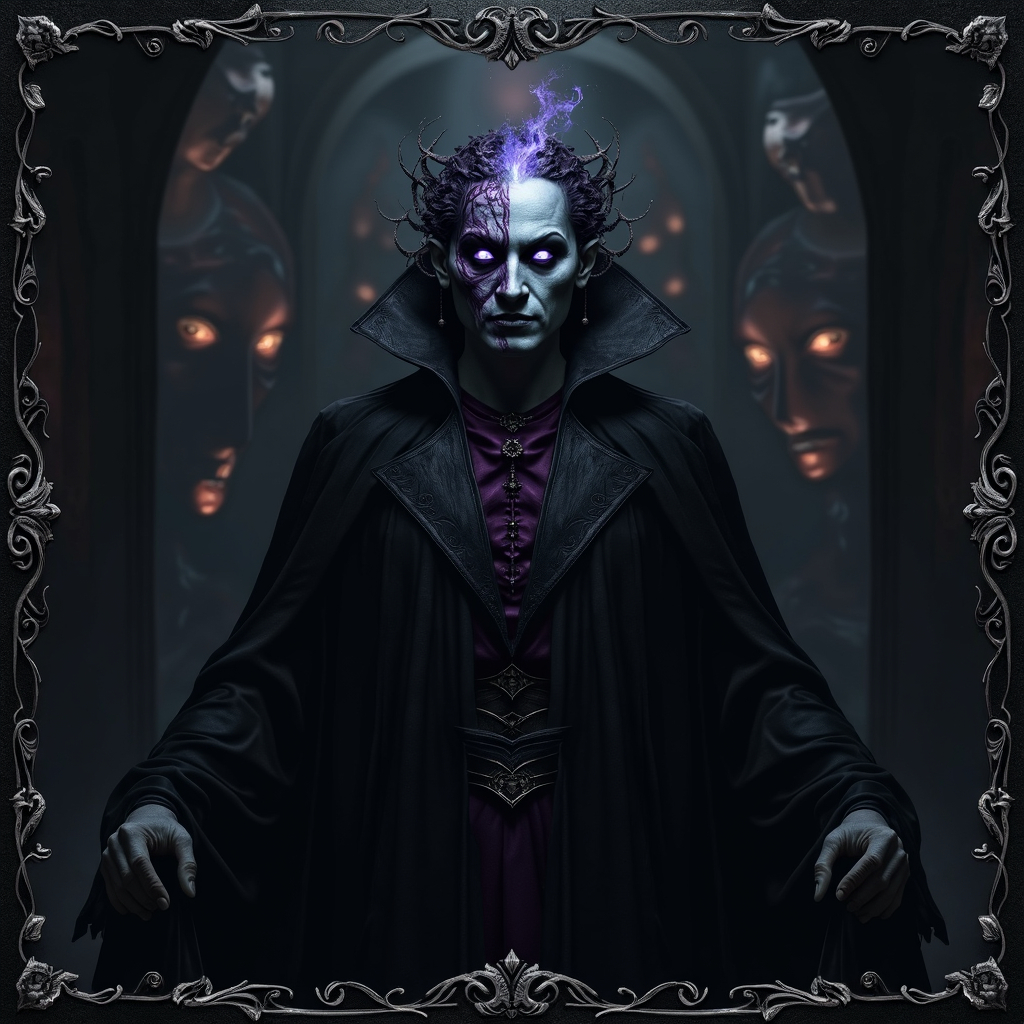
Silithus
God of deception and secrets. Patron to spies and illusionists.
“Trust not the silver tongue that weaves such honeyed lies, for beneath each word lies another face.”
Silithus, once a mortal of striking beauty and cunning wit, ascended to divinity through Kaos’s dark grace.
Whispers say his ambition caught the primordial’s eye — Kaos saw in him the perfect vessel for deception. Now known as
Silithus, God of Lies and Deception, he presides over secrets, illusions, and the art of masks. Though remarkably
charismatic, half of his visage is scarred by holy flame — a cruel reminder of his former humanity and the powers he
wields.
Symbols
- Two-faced mask: One side smooth and serene, the other grotesquely burned—symbolizes duality of truth and
falsehood.
- Burned Quill: An inkwell’s feather scorched at the nib, emblematic of writing false deeds and signing
secret pacts.
- Serpentine key: A twisting key said to unlock doors of perception and deceit.
Domains
- Secrets & Espionage:: Guardianship over hidden truths and clandestine networks.
- Deception and illusion: The forging and weaving of lies.
- Masks & Transformation: Facilitating literal and metaphoric shape-shifting.
Rites
- Veiling the truth: Spies and informants gather under moonlight, each donning dual masks—half pristine,
half charred—to honor Silithus’s fractured face. A contract is written in disappearing ink; once read and bound,
participants whisper their secret lies into a copper bowl and burn the text, sealing their deceit.
- Trial by mirror: Initiates stand before smoky mirrors recounting their greatest falsehood. The mirror’s
surface cracks if the deceit is profound, revealing a deeper hidden image beneath.
- Embrace the flames: In sacred temples, acolytes hold live candles to half their own faces; the wax burns
symbolize solidarity with Silithus’s scarred half and devotion to truth’s darker twin.
Lore
In his mortal life, Silithus was a nobleman renowned for beauty and charm, celebrated for his hypnotic eloquence.
But envy bred ambition — his hunger for influence led him to trafficing in court intrigue, spreading whispers that
toppled kings and built his own power.
When Kaos observed these machinations, he deemed Silithus a kindred spirit and offered divinity. The ceremony was
brutal: the flames of Kaos engulfed half of his face, searing flesh and binding his soul to primordial deceit.
Though scarred, Silithus emerged divine, eyes now glimmering with infinite cunning.
As a god, he built an empire of shadows: secret guilds, spy networks that stretch across realms, and hidden temples
behind false walls. His followers include intelligence brokers, master spies, illusionists, and those who thrive in
the murk between truth and lie.
Yet Silithus remains a paradox. While he champions lies, he values honesty among his own — betrayal within his cult
is punished worse than death. They say he can read truth through silence, unraveling the most elaborate deceptions
with a single glance. His temples are silent labyrinths where whispered secrets echo eternally; those who wander in
uninvited often unravel their own minds.
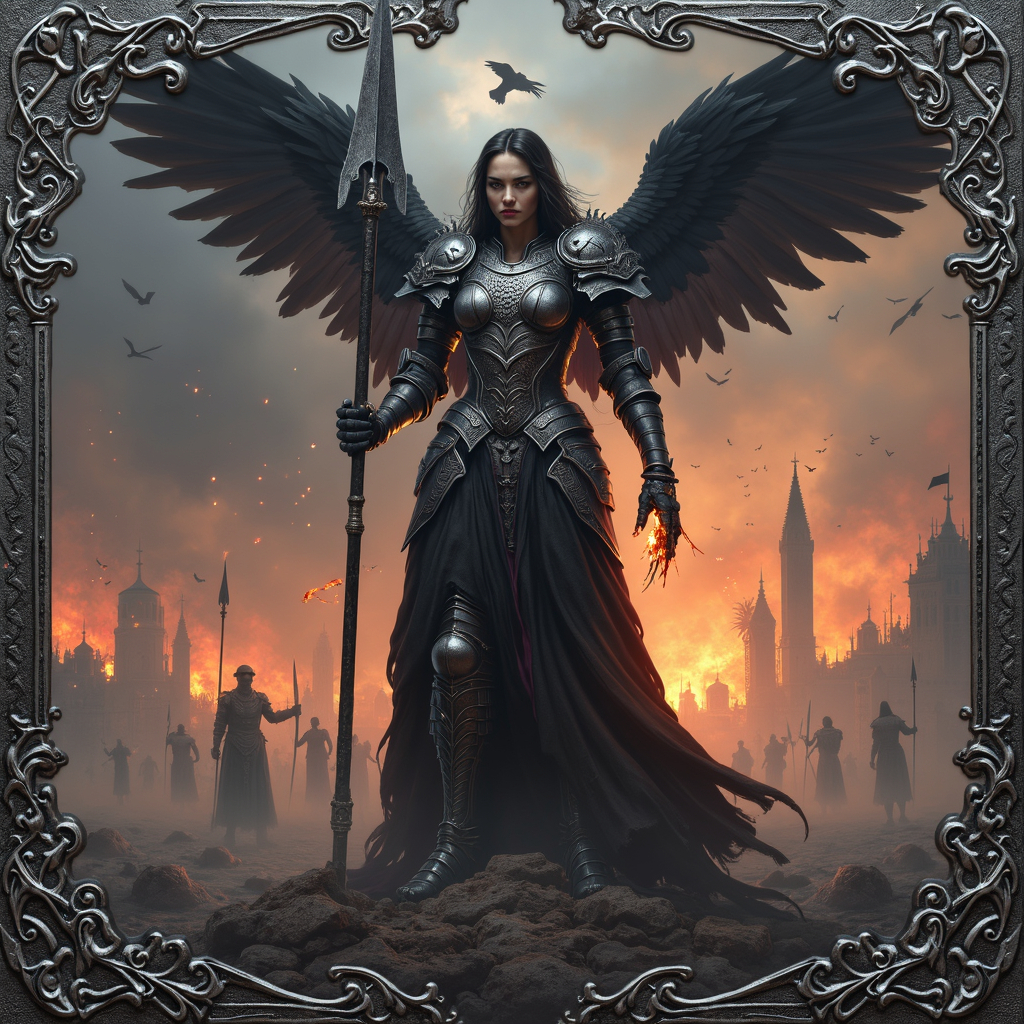
Leonarah
Goddess of war, conflict and battle. Patron to soldiers and gladiators.
![]()
Surrana
![]()
Cormarin
![]()
Sylka
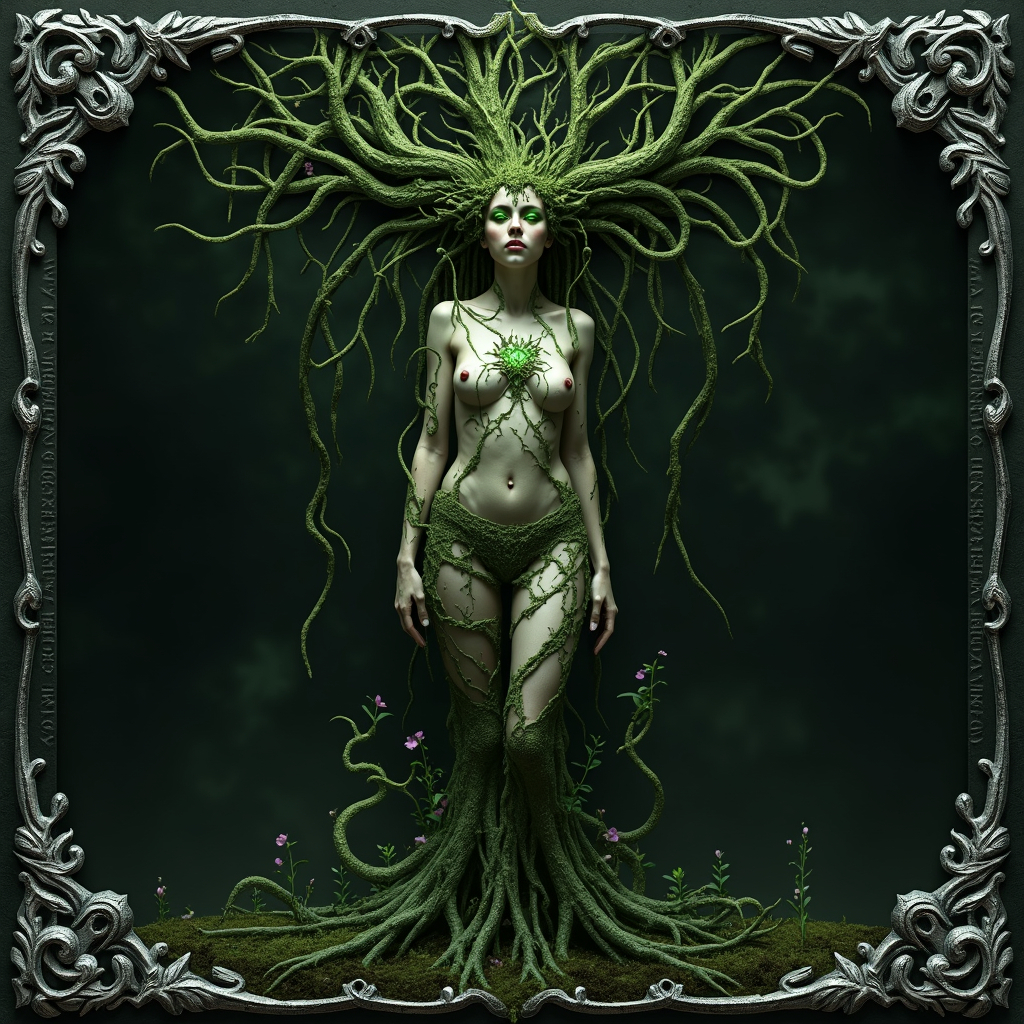
Than
Champion of the wood and nature's avenger. Patron and protector of Ku'Than.
"Let the trees bear witness, for those who scar the sacred earth shall find no mercy in my shadow." —
Than
Than, the ancient and enigmatic forest deity of Skazka, is a primal force of nature whose worship predates most
known religions in the world. Revered almost exclusively within the mysterious woodland realm of Ku’Than, Than
embodies the untamed spirit of the earth, meting out merciless vengeance on those who defile the sacred Elden
Wood.
Oft depicted as a horned figure with a face that communes through trees, Than’s presence is deeply felt rather
than
widely seen. Her priests and priestesses, known simply as Witches, are nurtured from childhood and tested
through a
brutal rite of survival before earning their place as guardians of the forest. Governed by the secretive Council
of
Than and led by High Witch Serona, the people of Ku’Than live in harmony with nature’s harsh order, believing
their
living forest to be both sanctuary and sentinel — perhaps even a prison to some ancient force. Outside their
dark
and
shifting woods, Than’s influence is rare, yet when a Witch emerges, it is a sign that something of great
consequence
stirs within the green heart of Skazka.
Symbols
- A Branched Tree with a Face: Explicitly described as her holy symbol, this image captures her
communion
with followers through the forest itself and reflects her embodiment of the sentient wilderness.
- Antlers: Than is often depicted with antlered horns, symbolizing primal power, wilderness, and her
kinship with untamed creatures.
- Twisted Vines or Roots: Representing the deep, binding force of nature and the hidden strength
beneath
the surface, they may also reflect the inescapable reach of her influence.
- The Forest Itself (Elden Wood): Not a traditional symbol, but emblematic of her essence—living,
shifting,
ancient, and sacred. Stylized forest motifs or silhouettes might appear in her iconography.
- Tree Bark Mask: Worn by her followers, this might symbolize the merging of identity
with the forest and Than's spirit.
- Coven Rings or Interlocking Circles: Representing the sacred bonds between witches and their
apprentices,
and the unity (and fatal link) within her faithful.
domains
-
Nature: Central to her worship, Than is deeply tied to the forest, the earth, and the preservation of
the
natural
world. Her followers revere untouched wilderness and act as its fierce protectors.
-
Vengeance: Than is described as uncompromising and intolerant of those who defile nature. Her Witches
actively seek
retribution against violators, suggesting this as a core aspect of her divine power.
-
Mystery or Secrets: The shrouded, ever-shifting forest and the little-known inner workings of Ku’Than
point
to a
domain over secrecy, hidden knowledge, or the unknown.
-
Fate or Trials: The demanding trials for becoming a Witch, and the idea that not all survive, may hint
that
Than
oversees tests of worth, destiny, or the forging of strength through adversity.
Rites
-
Rite of the Verdant Covenant (Initiation of Witchlings): This rite begins when a child is accepted into
the
path of Than.
The Weird (mentor Witch) performs a secretive ritual
at a sacred glade, marking the child with earth and sap to symbolize their rebirth into the forest’s will. The
child
is introduced to the spirits of the woods, often through dream or trance induced by herbal smoke, and given a
seed
to
plant — their first pact with Than.
-
Trial of Root and Shadow (Coming of Age)
At the age of maturity, Witchlings undergo a solitary survival ordeal: one year and one day alone in the Elden
Wood.
During this time, they must endure its dangers, earn the forest’s respect, and avoid becoming prey to both
beast
and
spirit. Survival is seen as Than’s personal approval; failure often means death — or worse, transformation
into
something unnatural.
-
Than'Dva (Witch-Pairing Ritual): Upon becoming a full Witch, the initiate is ritually bound to a
covenant-partner in a ceremony within a sacred cave known as the Sanctuary of Revelations.
The two Witches, naked and submerged in the pool, must share their most intimate secrets. They are then
visited by
the spirts of their ancestors who bless
and sponsor the bonding. Their fates are joined, their lives entwined — one cannot survive the other’s death.
-
The Vengeance Harvest: When someone defiles the forest, a coven may perform this rite under moonlight.
Witches gather around a tree bearing a
face of Than and invoke her fury through chanting, blood-letting, and binding effigies made from the
violator’s
discarded items. The rite often precedes a hunt — literal or spiritual — in which nature exacts retribution.
-
Rite of the Twisting Paths (Divination): This secretive rite is used to commune with Than or seek
guidance.
A Witch enters the forest alone,
ingesting sacred herbs, and follows an animal or tree spirit until a vision is granted. The forest itself
becomes
the altar, the voice,
and the veil between worlds.
-
Burial by the Roots: When a Witch dies, their body is not burned or entombed but returned to the
forest.
They are buried in fetal position
beneath a young sapling, believed to carry their spirit forward. A mask or symbol of their covenant may be
hung
from
the branches, marking their passage and presence in the trees.
lore
-
The Withering of Seroth Hollow: Long ago, on the western edge of the Elden Wood, there was a thriving
lumber village called Seroth Hollow. Nestled
dangerously close to the border of Ku’Than, its people grew bold with their axes and trade, felling ancient
trees
whispered to be older than the gods. Despite warnings etched into bark, the villagers pressed deeper into the
sacred
groves.
One night, the forest went silent. No wind, no birds, no life. The next morning, Seroth Hollow was gone. Not
burned, not razed — gone.
In its place, a hollow depression in the earth stretched like a wound, filled with twisted roots that groaned
with
the
sounds of human voices. The only sign of the village was a single, towering tree in the center, its bark
etched
with
dozens of human faces frozen in expressions of terror. The Witches of Than call it The Tree of Regret, and
they
say
each face is a soul bound to bark for eternity — not dead, not alive, but listening, eternally aware, feeding
the
tree’s
hunger for vengeance.
To this day, no birds fly above that place, and no creature sets foot there. Familiars warn Witchlings never
to
approach it alone, for the tree whispers in the voice of those it has consumed, calling for help in familiar
tones. Some who
answer never return. Others do — hollow-eyed, their voices splintered and sap dripping from their mouths.
It is said that the Tree of Regret is a fragment of Than’s wrath made manifest — a punishment not for one
crime,
but
for forgetting that the forest is older, crueler, and more sacred than man will ever be.
![]()
Ioun
![]()
Lunica
![]()
Mani








